This article contains information about the literary events and publications of 1555.

Olavinlinna is a 15th-century three-tower castle located in Savonlinna, Finland. It is built on an island in the Kyrönsalmi strait that connects the lakes Haukivesi and Pihlajavesi. It is the northernmost medieval stone fortress still standing. The castle forms a spectacular stage for the Savonlinna Opera Festival, which was held for the first time in the summer of 1912.

The Fenni were an ancient people of northeastern Europe, first described by Cornelius Tacitus in Germania in AD 98.

Carta marina et descriptio septemtrionalium terrarum is the first map of the Nordic countries to give details and place names, created by Swedish ecclesiastic Olaus Magnus and initially published in 1539. Only two earlier maps of the Nordic countries are known, those of Jacob Ziegler and Claudius Clavus.
The Gulon is a creature in Scandinavian legend, also known as a "Jerff" in Northern Sweden and "Vielfraß" in Germany. It resembles a hodgepodge of various animals, usually described as being the size and shape of a dog, with some cat-like features such as the head, ears, and claws. It also supposedly has a thick coat of shaggy brown fur and a tail resembling that of a fox.

The Viking revival was a movement reflecting new interest in, and appreciation for Viking medieval history and culture. Interest was reawakened in the late 18th and 19th centuries, often with added heroic overtones typical of that Romantic era.

The Archbishop of Uppsala has been the primate of Sweden in an unbroken succession since 1164, first during the Catholic era, and from the 1530s and onward under the Lutheran church.
Olaus Magnus was a Swedish writer, cartographer, and Catholic clergyman.

Johannes Magnus was the last functioning Catholic Archbishop in Sweden, and also a theologian, genealogist, and historian.

The Archdiocese of Uppsala is one of the thirteen dioceses of the Church of Sweden and the only one having the status of an archdiocese.
Germanic philology is the philological study of the Germanic languages, particularly from a comparative or historical perspective.
Kettil Runske was, according to Olaus Magnus' Historia de Gentibus Septentrionalibus (1555), the man who brought runes to humankind, by stealing three rune staffs from Odin from which he learnt the runes. An apprentice named Gilbert defied Kettil, who punished him by throwing a rune staff at him whereby he was imprisoned. Gilbert was for a long time imprisoned in a cave on Visingsö in Lake Vättern.

Gothicism or Gothism was a dacianistic cultural movement in Sweden, which took honor in being a Swede, who were related to the illustrious Goths as the Goths originated from Götaland. The founders of the movement were Nicolaus Ragvaldi and the brothers Johannes and Olaus Magnus. The belief continued to hold power in the 17th century, when Sweden was a great power following the Thirty Years' War, but lost most of its sway in the 18th. It was renewed by the Viking revival and Romantic nationalism in the early 19th century, this time with the Vikings as heroic figures.

The Madagascar serpent eagle is a species of bird of prey in the family Accipitridae. It is placed in the monotypic genus Eutriorchis. It is endemic to Madagascar. Its natural habitat is subtropical or tropical moist lowland forests. It is threatened by habitat loss.
Hippopodes, meaning "horse-footed," is an allegorical creature in Greek mythology that is often associated with greed. According to the myth, the Hippopodes were a tribe of beings with the lower bodies of horses and the upper bodies of men. They were said to have guarded a fabulous treasure, but their insatiable greed made them unwilling to share it with anyone. This greed ultimately led to their downfall. The allegory of the Hippopodes serves as a cautionary tale against the dangers of greed and avarice.

The kraken is a legendary sea monster of enormous size, etymologically akin to a squid or octopus, said to appear in the sea between Norway and Iceland. It is believed the legend of the Kraken may have originated from sightings of giant squid, which may grow to 12–15 m in length.
Kettil is a given name. Notable people with the name include:

Otter fishing is a fishing technique which uses trained otters to fish in rivers. This method has been practised since the 6th century in various parts of the world, and is still practiced in southern Bangladesh.
Humphrey Higgens (1907-1984) was a British book editor and translator who with Peter Fisher made the first complete English translation of Olaus Magnus's A Description of the Northern Peoples.

Vincent Obsopoeus was a German humanist, Latin poet, and translator active in the Reformation. His most famous work, De Arte Bibendi, was written and published in 1536. He published a second edition in 1537, and died in 1539.













